Previously: Hello Process! (El proceso como paradigma – Process Becomes Paradigm) and El proceso como paradigma: The Autonomous Automat.
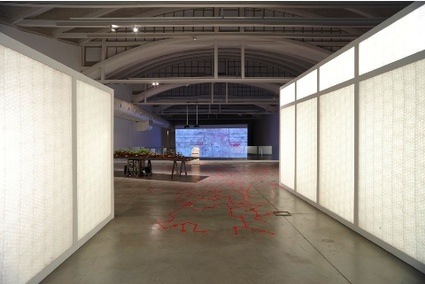 Luna Maurer, Red Fungus, 2010. Installation shot by Marcos Morilla
Luna Maurer, Red Fungus, 2010. Installation shot by Marcos Morilla
As i mentioned a few days ago, Laboral‘s new exhibition, El proceso como paradigma – Process Becomes Paradigm, showcases artworks which echo one of the major paradigms in contemporary art and culture: the shift from objects to process, from artefacts that land in a gallery as the finished result of a long work behind closed doors to artworks that might appear as ‘work in progress’. Process is not exclusive to media art. It does indeed connects the field with other art practices such as interventionism, land art and other works based on living matter, participative works, activism, etc.
To fully appreciate the show, visitors should come back once or twice over the course of this 5 month exhibition in order to see how the works have evolved over time, some in a more controllable and predictable way than others.
One of the sections of the exhibition, titled Engaging Human Agents, presents artworks that specifically require other people to engage in the realization process. This collaborative practice erodes the traditional model of creation which recognizes only one author.
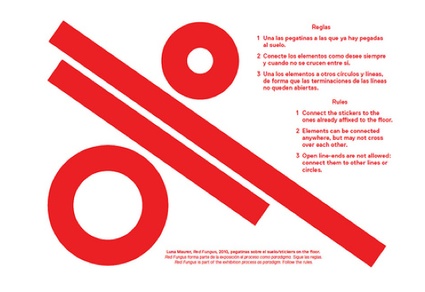 Luna Maurer, Red Fungus, 2010
Luna Maurer, Red Fungus, 2010
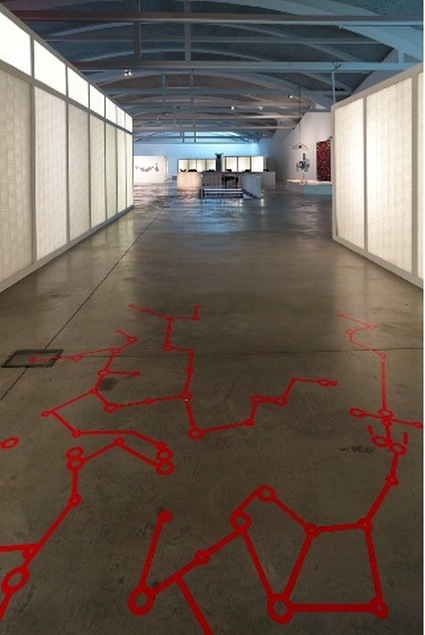 Luna Maurer, Red Fungus, 2010. Installation shot by Marcos Morilla
Luna Maurer, Red Fungus, 2010. Installation shot by Marcos Morilla
Luna Maurer‘s Red Fungus is an ultra-simple and ingenious ‘generative installation’ that the artist first developed in a blue version for the exhibition Deep Screen at the Stedelijk Museum in 2008. Each visitor of Laboral receives a set of four stickers upon entering the building. They are invited to affix the stickers on the exhibition floor. Anywhere will do as long as the sticker connects to the ones already on the floor. The simple gesture, repeated again and again, turns into a complex, collaborative image.
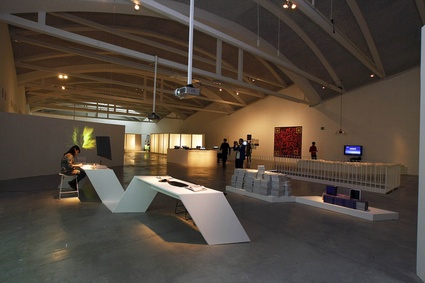 Manu Luksch and Mukul Patel, Love, Piracy and the Office of Religious Weblog Expansion. Image courtesy Laboral
Manu Luksch and Mukul Patel, Love, Piracy and the Office of Religious Weblog Expansion. Image courtesy Laboral
Love, Piracy, and the Office of Religious Weblog Expansion is the transcript of an interview of the same name with Iranian philosopher Ali Alizadeh about the history of censorship in Iran from the 1979 Revolution to the age of Google. The interview was printed in books but of the philosopher’s 1,500 word-long responses, only one word is left legible. All the others have been censored. The remaining word however, is a different one in each copy of the edition of 1,500. Owners of the book can frustrate censorship by sharing online the unique word of text left visible in each copy. Once a word has been submitted to the website, it is permanently revealed online. The entire text will be rendered visible only if all book owners share their words online. While i was visiting the show, people were relaying each other to patiently cover with a black line each word that had to be censored in each of the 1,500 copies.
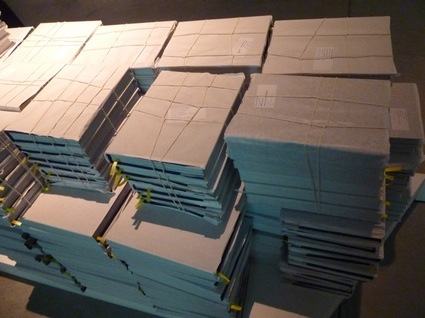
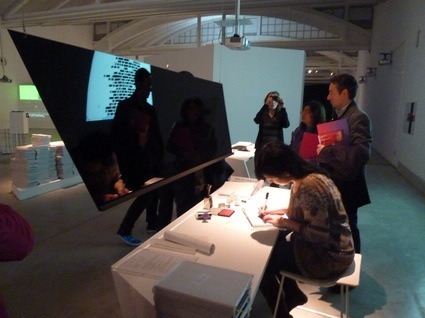 Manu Luksch and Mukul Patel, Love, Piracy and the Office of Religious Weblog Expansion
Manu Luksch and Mukul Patel, Love, Piracy and the Office of Religious Weblog Expansion
I was going to focus solely on the thread Engaging Human Agents but that would have meant ignoring the work i liked the best in the exhibition.
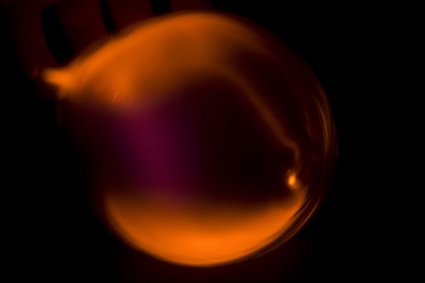 Installation, EMAF 2010
Installation, EMAF 2010
Jan-Peter E.R. Sonntag‘s Warden Sprites, part of the Between Simulation and Fiction section, is inspired by the research of pioneer of polar light studies Karl Selim Lemström. The 19th century explorer and scientist built the first and only machines on a mountain in Lapland which created artificial induced aurora borealis.
The work also reconnects with the Inuit who claimed to be able to hear the northern lights (aurora borealis) when the ancestral spirits establish contact with humans. Ernest W. Hawkes mentioned their belief in his book, The Labrador Eskimo.
“The sky is a great dome of hard material arched over the earth. There is a hole in it through which the spirits pass to the true heavens. (…) This is the light of the aurora. (…) The whistling crackling noise which sometimes accompanies the aurora is the voices of these spirits trying to communicate with the people of the earth.”
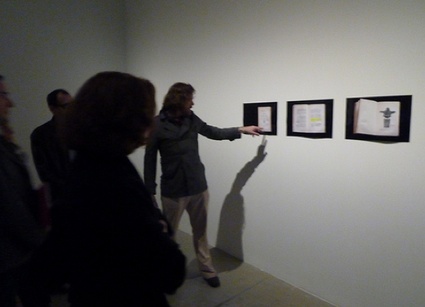
For the Laboral exhibition, Sonntag has lined up on the wall some textual references to the myth. Meanwhile in the adjacent and dark room, an audiobeam makes the spherical crackling of the solar wind audible.
I’m copy/pasting the technical explanations because i doubt i could do better: The artist transforms atmospheric plasma live stream data into modulated air and electromagnetic UV-waves which flash as visible low-frequency red sprites under the ceiling of the black perception space. In the installation a standing pressure sinus wave is structuring the invisible Euclidian architecture with an amorphous field. A computer-system in the exhibition will dive through the aether space formed by Extremely Low Frequency (ELF)-data-streams. The received natural ELF-waves are pitched into the ultraviolet part of the electromagnetic spectrum. Through a specially developed tweeter beam the high tone sound wave is projected to the ceiling inside the black cube where it reflects as sound figures and low red electromagnetic waves (as “whistlers” and “cracklers”), sferics and red luminous flashes.
Last images from the show before i move to the next adventures:
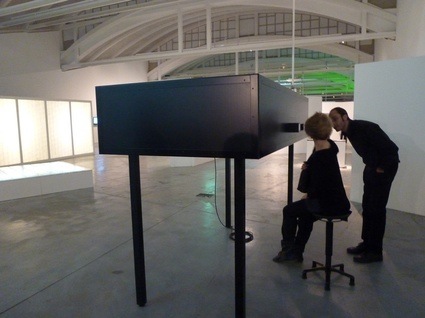 Driessens & Verstappen, Sandbox
Driessens & Verstappen, Sandbox
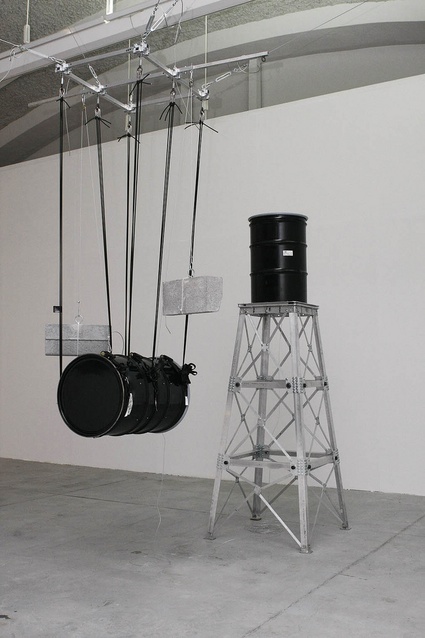 Peter Flemming, Leak to Lower Lazy Levitating Load. Image courtesy Laboral
Peter Flemming, Leak to Lower Lazy Levitating Load. Image courtesy Laboral
El proceso como paradigma – Process Becomes Paradigm is on view at Laboral Art and Industrial Creation Centre in Gijón until August 30, 2010.
